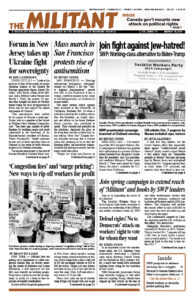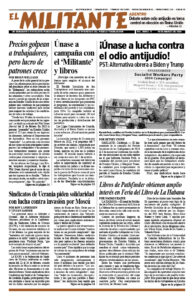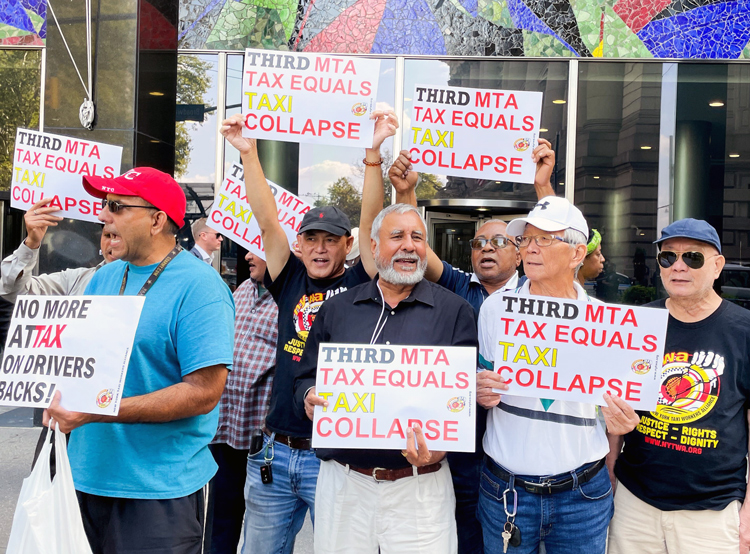NEW YORK — Officials here are getting set to implement so-called congestion pricing fees on drivers entering the streets of Midtown and Lower Manhattan, a stiff regressive tax that falls most heavily on working people. Projected as a move to save the environment, in reality it’s a boon to line the pockets of wealthy bondholders.
Drivers will be charged for going south of 60th Street, which includes coming off any bridge, tunnel or highway in this area. Prices range from a once-a-day toll of $15 for passenger vehicles to $24 to $36 for trucks. Yellow cab taxi drivers will have to pay a $1.25-per-ride toll to enter this zone; Uber, Lyft and other e-hail drivers, $2.50 per ride.
These costs come on top of already steep bridge and tunnel tolls just to get into the city, currently $15.38 for the Lincoln Tunnel, if you’ve got an E-ZPass.
A network of cameras and sensors have already been installed at over 100 locations to snap photos of vehicles, including their front and back license plates, as they enter the “congestion zone.” Fees will be added onto E-ZPass bills. For those who don’t have E-ZPass, bills will be sent to vehicle owners by mail. The surveillance network is programmed to assess the toll based on the size and shape of your vehicle.
This rip-off is being organized by the Metropolitan Transportation Authority, which claims that these additional funds will generate $1 billion per year. It would then use this manna from heaven to purchase $15 billion in bonds for capital improvements. The bonds are triple guaranteed, a profit bonanza for well-heeled coupon clippers.
But the MTA is already buried in $48 billion in debt with increasing interest payments to the bondholders, and the city government prioritizes paying them above all else. Even with increased bus and subway fares being imposed on working people, city authorities say there aren’t enough funds to rebuild, repair and keep running the more than 100-year-old transit system. Hence “congestion pricing.”
Even though the plan has already been approved by the state, the MTA conducted four hearings between Feb. 29 and March 4 where those for and against the new scheme could blow off steam. This would “put me over the edge,” Manhattan resident Linda Nicholas said at the Feb. 29 hearing. “For many of us who are struggling to make ends meet, an additional daily fee represents a substantial burden that will force sacrifices in other areas, such as food.”
“I hate that the working class doesn’t have a say,” John Gerald, a construction worker who uses his car to drive from Astoria, Queens, with his tools, told the New York Post outside the March 1 hearing. “The only people that suffer from this is the people that already can’t afford their bills. And that’s me.”
The New York City Municipal Labor Committee, comprising nearly 400,000 government workers, opposes the tax. Public Advocate Jumaane Williams says it’s needed to protect the environment. “Our planet is in jeopardy now,” he told a recent rally.
Several lawsuits have been filed in federal courts in New Jersey and New York against the congestion plan, including by the United Federation of Teachers and New Jersey Gov. Philip Murphy. If they’re unsuccessful, the MTA says it will be ready to start collecting the toll June 15.
Similar plans are being considered in Chicago, Los Angeles, Washington, D.C., and other cities.
‘Surge’ pricing
In a related income-boosting scheme, Wendy’s CEO Kirk Tanner announced plans Feb. 27 to introduce “surge” pricing, which created quite a stir among the fast-food chain’s customers and its competitors, like Burger King. The idea is to boost the price of food items when the store is busy, then bring them back down at other times. It would be like congestion pricing for fast food.
The following day, in response to an overwhelmingly unfavorable reaction, Wendy’s officials announced their plan had been “misconstrued in some media” and they have “no plans” to “raise prices when demand is highest at our restaurants.”
Instead, essentially saying the same thing, they said they would “offer discounts and value offers to our customers more easily, particularly in the slower times of day.” This would be like “happy hour” or “early-bird specials,” like other restaurants use to attract more customers.
Restaurant prices have risen relentlessly over the past couple of years. It’s now much more expensive to take one’s family out for a burger or anything else.
A burger, fries and a soda at Burger King in New York goes for $14.22.


